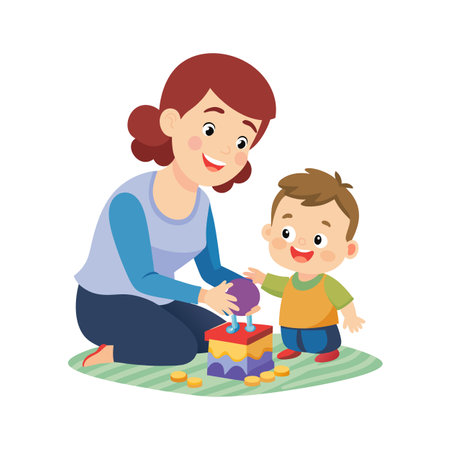1. Building a Strong Foundation of Love and Trust
As a single parent, one of the most important things you can do for your child is to create a safe and supportive environment where they feel loved and valued. This foundation of love and trust will help them develop confidence and independence as they grow.
Creating a Safe and Supportive Environment
Your home should be a place where your child feels emotionally secure. Open communication, consistent routines, and clear expectations help build this sense of security. Here are some key ways to foster a loving and trusting environment:
| Strategy | Description |
|---|---|
| Active Listening | Give your child your full attention when they talk, making them feel heard and understood. |
| Consistent Routines | Establish daily routines that provide structure and stability in their life. |
| Praise and Encouragement | Acknowledge their efforts and achievements to build their confidence. |
| Setting Boundaries with Love | Create clear rules while explaining the reasons behind them, reinforcing trust. |
The Power of Unconditional Love
Your child needs to know that your love is not dependent on their actions or achievements. Expressing love through words, hugs, and quality time reassures them that they are valued no matter what. Simple gestures like leaving a note in their lunchbox or having regular one-on-one time can strengthen your bond.
Encouraging Open Communication
A strong parent-child relationship is built on honest conversations. Encourage your child to share their feelings, ask questions, and express concerns without fear of judgment. By being approachable and understanding, you create an environment where they feel comfortable seeking guidance when needed.
The Role of Trust in Independence
Trust goes both ways—your child needs to trust you, but they also need to feel trusted. Giving them age-appropriate responsibilities, allowing them to make small decisions, and respecting their opinions helps develop their independence. Small steps toward responsibility, like letting them choose their clothes or manage their own homework schedule, build confidence over time.
2. Encouraging Age-Appropriate Responsibilities
Teaching children responsibility starts with small, manageable tasks that align with their developmental stage. By giving them opportunities to make decisions and take ownership of daily responsibilities, you help build their confidence and independence.
Assigning Tasks Based on Age
Children thrive when they have clear expectations. Assigning age-appropriate tasks allows them to develop a sense of responsibility while feeling capable and valued. Below is a simple guide to help assign tasks based on your child’s age:
| Age Group | Suggested Responsibilities |
|---|---|
| 2-4 years old | Putting toys away, placing dirty clothes in the hamper, wiping small spills |
| 5-7 years old | Setting the table, feeding pets, making the bed |
| 8-10 years old | Packing school bags, folding laundry, helping with meal prep |
| 11+ years old | Mowing the lawn, preparing simple meals, managing their own schedule |
The Power of Choice and Decision-Making
A great way to encourage responsibility is by allowing children to make small decisions within safe boundaries. This could be as simple as choosing their outfit for the day or deciding which household task they want to complete first.
Simple Ways to Offer Choices:
- “Would you like to set the table or help wash the dishes?”
- “Do you want to do your homework before or after dinner?”
- “Would you prefer packing your lunch tonight or in the morning?”
Praising Effort Over Perfection
Avoid expecting perfection when assigning responsibilities. Instead, focus on effort and improvement. Praise their willingness to contribute rather than just the outcome. This helps build confidence and encourages them to keep trying.
Examples of Encouraging Phrases:
- “I love how you remembered to feed the dog today!”
- “You did such a great job setting the table—thank you for helping!”
- “I see youre trying really hard to fold your clothes neatly. Keep practicing, youre getting better!”
Nurturing responsibility in a single-parent home may take patience, but giving your child tasks that match their abilities helps them grow into independent individuals who feel capable and valued.

3. Fostering Problem-Solving and Critical Thinking
As a single parent, one of the most valuable skills you can teach your child is how to solve problems independently. Encouraging them to think critically and make responsible choices not only builds confidence but also prepares them for real-world challenges.
Encouraging Independent Thinking
Children often look to their parents for immediate answers, but guiding them to find solutions on their own strengthens their decision-making abilities. Instead of providing instant solutions, try asking open-ended questions like:
| Scenario | Guiding Question |
|---|---|
| Your child forgot their homework at home. | “What could you do differently next time to remember your homework?” |
| Your child is struggling with a disagreement with a friend. | “How do you think your friend feels? What are some ways you can solve this problem together?” |
| Your child cant decide between two activities. | “What are the pros and cons of each choice? Which one aligns more with your goals?” |
Teaching Decision-Making Skills
Helping children understand the consequences of their decisions is key to building responsibility. Encourage them to weigh their options by discussing possible outcomes before making a choice.
The “Think Before You Act” Strategy
- Identify the Problem: What is the challenge or decision at hand?
- Consider Possible Solutions: What are different ways to handle the situation?
- Evaluate Outcomes: What might happen if each option is chosen?
- Make a Decision: Choose the best solution based on logic and reasoning.
- Reflect on the Choice: Afterward, discuss what worked well and what could be improved.
Praising Effort Over Perfection
Mistakes are a natural part of learning. Instead of focusing on whether they made the “right” decision, acknowledge their effort in thinking critically and problem-solving. Phrases like “I love how you thought that through” or “That was a creative solution!” reinforce their confidence and willingness to take initiative.
4. Balancing Support and Independence
As a single parent, finding the right balance between supporting your child and encouraging independence can be challenging. You want to be there for them, but you also want to help them grow into capable and responsible individuals. Knowing when to step in and when to step back is key to fostering their confidence and self-sufficiency.
Encouraging Problem-Solving Skills
One of the best ways to promote independence is by allowing your child to solve problems on their own before stepping in. Instead of immediately offering a solution, ask guiding questions like:
- “What do you think you should do?”
- “Have you faced a similar situation before?”
- “What are some possible solutions?”
This approach helps children develop critical thinking skills and boosts their confidence in handling challenges independently.
Providing Age-Appropriate Responsibilities
Giving your child responsibilities that match their age helps them build independence while still feeling supported. Here’s a simple guide:
| Age Group | Suggested Responsibilities |
|---|---|
| 4-6 years old | Packing their backpack, putting away toys, setting the table |
| 7-9 years old | Making simple snacks, feeding pets, organizing school supplies |
| 10-12 years old | Laundry sorting, helping with meal prep, managing homework schedule |
| 13+ years old | Cooking simple meals, budgeting allowance, running small errands |
The Importance of Letting Them Fail Safely
Mistakes are an essential part of learning. While it can be tempting to prevent your child from failing, allowing them to experience small setbacks teaches resilience. If they forget their homework or mismanage their time, resist the urge to fix it for them. Instead, guide them through problem-solving strategies so they learn how to handle similar situations in the future.
A Supportive Yet Independent Mindset
Your role as a single parent is to provide guidance without overshadowing your childs ability to learn and grow. By gradually increasing their responsibilities and giving them space to make decisions, youre setting them up for success in adulthood. The key is finding that delicate balance between being supportive and stepping back when necessary.
5. Leading by Example: Modeling Independence and Responsibility
As a single parent, one of the most powerful ways to teach your child independence and responsibility is by leading through example. Children learn not just from what we say but from what we do. Demonstrating self-reliance, resilience, and responsibility in your own actions sets a strong foundation for your child to follow.
Show Self-Reliance in Daily Life
Your child observes how you handle challenges, manage responsibilities, and make decisions. Show them that you are capable of taking care of yourself and your household efficiently. This helps them understand the importance of being independent and taking ownership of their own tasks.
Ways to Demonstrate Self-Reliance
| Action | How It Helps Your Child |
|---|---|
| Managing finances responsibly | Teaches financial literacy and the value of budgeting |
| Handling daily chores without procrastination | Encourages accountability and time management |
| Making thoughtful decisions independently | Demonstrates problem-solving and critical thinking skills |
| Pursuing personal goals and self-improvement | Inspires ambition and perseverance |
Cultivate Resilience Through Challenges
Your child will inevitably face difficulties in life. By showing resilience in tough times, you provide them with a model for handling adversity. Instead of hiding struggles, use them as learning opportunities. Talk about how you approach problems, adapt to change, and stay positive despite obstacles.
Teach Problem-Solving Skills
- Acknowledge challenges: Let your child see that setbacks are a normal part of life.
- Troubleshoot together: When appropriate, involve them in finding solutions.
- Diversify coping strategies: Share techniques like deep breathing, positive thinking, or seeking help when needed.
- Celebrate persistence: Recognize efforts rather than just outcomes.
Taking Responsibility for Your Actions
If you want your child to take responsibility for their actions, they need to see you doing the same. Admit mistakes when they happen, apologize sincerely, and demonstrate how to correct them. This shows that responsibility isn’t about perfection but about accountability and growth.
Create a Household Culture of Responsibility
You can encourage responsibility by making it a shared value within your home. Assign age-appropriate tasks to your child so they actively participate in maintaining the household.
A Simple Chore Chart Example
| Age Group | Chores They Can Do |
|---|---|
| Toddlers (2-4 years) | Picking up toys, putting laundry in a basket |
| Younger Kids (5-8 years) | Making their bed, setting the table, feeding pets |
| Tweens & Teens (9+ years) | Laundry, cooking simple meals, managing their schedule |
Your leadership as a role model has a lasting impact on your childs development. By demonstrating self-reliance, resilience, and responsibility in your daily actions, you empower them to grow into confident and capable individuals.


